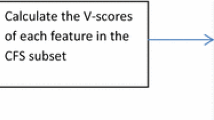Abstract
The attribute selection techniques for supervised learning, used in the preprocessing phase to emphasize the most relevant attributes, allow making models of classification simpler and easy to understand. The algorithm has some interesting characteristics: lower computational cost (O(m n log n) m attributes and n examples in the data set) with respect to other typical algorithms due to the absence of distance and statistical calculations; its applicability to any labelled data set, that is to say, it can contain continuous and discrete variables, with no need for transformation. In order to test the relevance of the new feature selection algorithm, we compare the results induced by several classifiers before and after applying the feature selection algorithms.
Preview
Unable to display preview. Download preview PDF.
Similar content being viewed by others
References
Aguilar-Ruiz, J.S., Riquelme, J.C., Toro, M.: Data Set Editing by Ordered Projection. Intelligent Data Analysis Journal 5(5), 1–13 (2001)
Almuallim, H., Dietterich, T.G.: Learning boolean concepts in the presence of many irrelevant features. Artificial Intelligence 69(1-2), 279–305 (1994)
Blake, C., Merz, E.K.U.: Repository of machine learning databases (1998)
Hall, M.A.: Correlation-based feature selection for machine learning. PhD thesis, Department of Computer Science, University of Waikato, Hamilton, New Zealand (1998)
Hoare, C.A.R.: QuickSort. Computer Journal 5(1), 10–15 (1962)
Kira, K., Rendell, L.: A practical approach to feature selection. In: Proceedings of the Ninth International Conference on Machine Learning, pp. 249–256. Morgan Kaufmann, San Francisco (1992)
Kohavi, R., John, G.H.: Wrappers for feature subset selection. Artificial Intelligence 97, 273–324 (1997)
Kononenko, I.: Estimating attibutes: Analisys and extensions of relief. In: Proceedings of the Seventh European Conference on Machine Learning, pp. 171–182. Springer, Heidelberg (1994)
Quinlan, J.: C4.5: Programs for machine learning. Morgan Kaufmann, San Francisco (1993)
Robnik-Ŝikonja, M., Kononenko, I.: An adaption of relief for attribute estimation in regression. In: Proceedings of the Fourteenth International Conference on Machine Learning, pp. 296–304. Morgan Kaufmann, San Francisco (1997)
Setiono, R., Liu, H.: A probabilistic approach to feature selection-a filter solution. In: Proceedings of International Conference on Machine Learning, pp. 319–327 (1996)
Author information
Authors and Affiliations
Editor information
Editors and Affiliations
Rights and permissions
Copyright information
© 2003 Springer-Verlag Berlin Heidelberg
About this paper
Cite this paper
Ruiz, R., Riquelme, J.C., Aguilar-Ruiz, J.S. (2003). Fast Feature Ranking Algorithm. In: Palade, V., Howlett, R.J., Jain, L. (eds) Knowledge-Based Intelligent Information and Engineering Systems. KES 2003. Lecture Notes in Computer Science(), vol 2773. Springer, Berlin, Heidelberg. https://doi.org/10.1007/978-3-540-45224-9_46
Download citation
DOI: https://doi.org/10.1007/978-3-540-45224-9_46
Publisher Name: Springer, Berlin, Heidelberg
Print ISBN: 978-3-540-40803-1
Online ISBN: 978-3-540-45224-9
eBook Packages: Springer Book Archive




